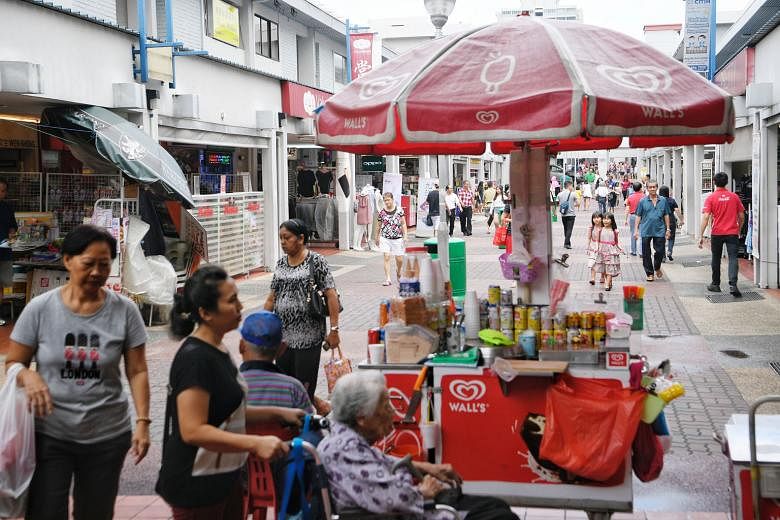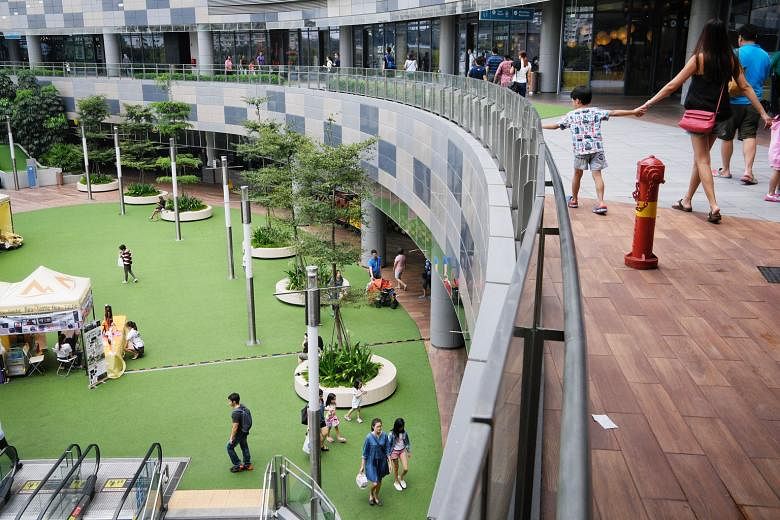Mr Kelvin Cham lives in Punggol but feels that Bedok is more like home.
The 31-year-old accountant and his wife regularly make the 20-minute drive to hawker centres at the mature estate, where friendly strangers ask about the dishes they are eating and make small talk.
In contrast, he finds that people in the new town of Punggol keep to themselves, even though most of them are of a similar age.
"In Punggol, no one talks," he said, while having lunch at a hawker centre in Block 208, New Upper Changi Road, last Saturday.
"Maybe it's because we're all at the same stage of life so there's either no small talk left to make, or an unspoken sense of competition makes us more prone to comparison, but you don't get the warmth you do at older estates."
That the kampung spirit and vibrancy of Housing Board towns built during the first wave in the 1960s and 1970s, such as Ang Mo Kio and Clementi, are found lacking in the newer ones like Sengkang and Punggol built in the 1990s and 2000s has long been noted.
In the newer towns, the planning structure of having a town centre encircled by neighbourhoods of about 4,000 to 6,000 flats, and which are further subdivided into precincts of about 400 to 800 units, does not seem to encourage the same level of camaraderie easily witnessed in older estates.
Observers pinpoint a key factor: the paucity of hawker centres and street-level shops in the newer towns that serve as common spaces for residents to meet and mingle.
For example, there are no hawker centres in Punggol and Sengkang, though the authorities have planned for two and three in the respective locations by 2027 - part of an overall plan for 20 centres to add 800 cooked food stalls across the island.
In a country where people live to eat, hawker centres are a critical node through which residents pass and relationships form.
"When you eat at a hawker centre, you watch your neighbours go by and say hello or nod your head. You make friends with your favourite hawker," said lifelong Bukit Merah resident and business development manager Desiree Teoh, 34.
"These little actions add up and, over time, you feel grounded to a place," she added.
Pasir Ris-Punggol GRC MP Sun Xueling said: "As amenities take time to be built, we are creating other community bonding points like a linear park and community centres in the meantime."
Traditional street-level shops - or at least those still owned by individuals, not chains - play a similar role.
Said Bedok goldsmith Lim Chin Yeow, 61, who has run a store for over 30 years: "Most of our customers are regulars with whom we have a relationship. They bought gold for their children, now they buy gold for their grandchildren. You can't find this sort of relationship in a regular mall."
But such shops are not as common in new estates.
One reason is that newer estates have not reached their full capacity yet and, as such, a critical mass needed to support a variety of stores has not been reached, observers said. In Punggol, where there are a projected 96,000 dwelling units in total, about 50,000 have been completed to date. This is on a par with a mid-sized town such as Yishun, which has 60,000 units.
The HDB has also moved away from such shops, discontinuing the direct sale of shops and hawker stalls to private landlords in 1998, six years after the scheme was introduced, amid a then slowing economy and poor take-up rate.
Instead, it has opted for next-generation neighbourhood centres - essentially malls hosting a number of shopping, dining, educational and entertainment options - in Punggol, Sembawang and Hougang. These centres would also be located near transport nodes and have sheltered community plazas for residents to meet or host events.
The centres were meant to cater to "changing demographics and lifestyle trends", HDB said at the time.
To its credit, HDB is often finding ways to design new estates in ways that encourage better bonding. For example, void decks - a 1970s feature meant to give residents more opportunities for informal meetings - have since evolved into "community living rooms", with tables and seats and located near playgrounds and other footpaths.
More recently, it signed a $6 million agreement with the Singapore University of Technology and Design (SUTD) earlier this month to look at how to create the "new urban kampung". The three-year project aims to encourage better social interaction among residents, through a combination of data analytics and behavioural studies.
Assistant Professor Chong Keng Hua, who is part of SUTD's research team, is optimistic that modern estates can be structured differently and still build a sense of community over time. "It works as long as there is something for everyone. As long as there is a place for diverse residents to feel relevant and connected, the modern neighbourhood can be close-knit," he said.
For example, apps could bring together various interest groups, such as cycling enthusiasts who could publish their cycling mileage and make recommendations on scenic or safer routes in the neighbourhood, he said.
In a statement yesterday, HDB added that town planning is a "continuous, evolving and cyclical process" - one that requires regular consultations with multiple agencies to "ensure that the town remains liveable and the facilities provided are relevant".
National University of Singapore urban planning expert Steven Choo said a town's vibrancy also transcends having a critical mass of people or amenities. "Vibrancy has a lot to do with evolution and the 'spirit of a place'," he said, adding that it takes at least one to two decades for a neighbourhood to "grow".
"At hawker centres and markets in older towns, you'll always find folks who used to live there and go back to their favourite stalls even though they have moved away. But that takes time to develop," he said.
For at least one Bedok resident, Punggol holds promise. Housewife Nurrashida Mohktar, 39, said she is drawn to the "better" designs of newer HDB estates, including their larger windows and community spaces, and hopes to move her family of four over soon.
She said: "If you stay at any place long enough, you'll start to build relationships. So why not sink your roots in a more modern town?"



